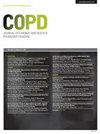Acute Exacerbation and Longitudinal Lung Function Change of Preserved Ratio Impaired Spirometry
IF 3.1
3区 医学
Q1 Medicine
International Journal of Chronic Obstructive Pulmonary Disease
Pub Date : 2024-02-23
DOI:10.2147/copd.s445369
引用次数: 0
Abstract
Background: Preserved ratio impaired spirometry (PRISm) is a heterogeneous disease entity. Limited data are available regarding its prevalence, clinical course, or prognosis. We aimed to evaluate the longitudinal clinical course of patients with PRISm compared with chronic obstructive pulmonary disease (COPD).Methods: A retrospective study enrolled PRISm and COPD patients who underwent chest computed tomography and longitudinal pulmonary function tests between January 2013 and December 2020. We compared the incidence of acute exacerbations and lung function changes between PRISm and COPD patients.
Results: Of the 623 patients, 40 and 583 had PRISm and COPD, respectively. Compared to COPD patients, PRISm patients were younger, more likely to be female and have a history of tuberculosis, and less likely to be smokers. They also had less severe comorbidities, lower forced vital capacity (FVC) and diffusing capacity of the lungs for carbon monoxide (DLCO). The clinical course was not significantly different between the PRISm and COPD patients in terms of the risk of moderate-to-severe acute exacerbations or proportion of frequent exacerbators. During follow-up, PRISm patients had a significantly slower annual decline of forced expiratory volume in 1 second, FVC, and DLCO than COPD patients.
Conclusion: PRISm patients had no significant difference in the risk of acute exacerbations, but a significantly slower decline of lung function during longitudinal follow-up, compared with COPD patients.
Plain Language Summary: We evaluated the longitudinal clinical course of patients with preserved ratio impaired spirometry (PRISm) compared to patients with chronic obstructive pulmonary disease (COPD). PRISm and COPD patients showed no significant differences in the risk of moderate-to-severe acute exacerbations or frequent exacerbations, but the former group showed a significantly slower annual decline of lung function during longitudinal follow-up.
急性加重与肺功能纵向变化之肺活量保留比值受损
背景:肺活量保留比值受损(PRISm)是一种异质性疾病。有关其发病率、临床过程或预后的数据十分有限。我们旨在评估 PRISm 患者与慢性阻塞性肺病(COPD)患者的纵向临床过程:一项回顾性研究纳入了在 2013 年 1 月至 2020 年 12 月期间接受胸部计算机断层扫描和纵向肺功能测试的 PRISm 和 COPD 患者。我们比较了 PRISm 和 COPD 患者的急性加重发生率和肺功能变化:在 623 名患者中,分别有 40 人和 583 人患有 PRISm 和 COPD。与慢性阻塞性肺病患者相比,PRISm 患者更年轻,更可能是女性,有结核病史,吸烟的可能性较小。他们的并发症也较少,用力肺活量(FVC)和肺对一氧化碳的弥散能力(DLCO)较低。就中度至重度急性加重的风险或频繁加重者的比例而言,PRISm 患者与慢性阻塞性肺病患者的临床过程没有明显差异。在随访期间,PRISm 患者一秒钟用力呼气量、FVC 和 DLCO 的年下降速度明显慢于 COPD 患者:结论:与慢性阻塞性肺疾病(COPD)患者相比,PRISm 患者的急性加重风险无明显差异,但在纵向随访期间肺功能下降速度明显较慢。PRISm患者和慢性阻塞性肺病患者在中重度急性加重或频繁加重的风险方面没有明显差异,但在纵向随访期间,前者的肺功能每年下降的速度明显较慢。
本文章由计算机程序翻译,如有差异,请以英文原文为准。
求助全文
约1分钟内获得全文
求助全文
来源期刊

International Journal of Chronic Obstructive Pulmonary Disease
RESPIRATORY SYSTEM-
CiteScore
5.10
自引率
10.70%
发文量
372
审稿时长
16 weeks
期刊介绍:
An international, peer-reviewed journal of therapeutics and pharmacology focusing on concise rapid reporting of clinical studies and reviews in COPD. Special focus will be given to the pathophysiological processes underlying the disease, intervention programs, patient focused education, and self management protocols. This journal is directed at specialists and healthcare professionals
 求助内容:
求助内容: 应助结果提醒方式:
应助结果提醒方式:


